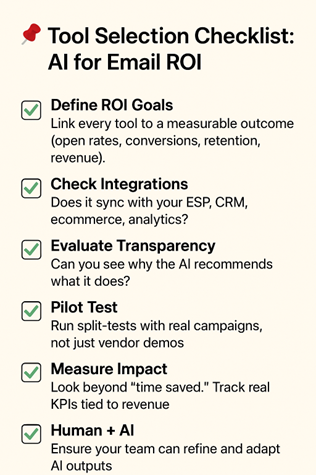AI in Action: Selecting Tools That Deliver Real Email Marketing ROI
Email marketers are turning to AI faster than ever – but with so many tools on the market, how do you know which ones actually deliver ROI, and which are just hype? The key is not in adopting AI for AI’s sake(big mistake), but in selecting tools that connect directly to performance outcomes.
In this post, I’ll share a framework for evaluating AI-driven email tools, highlight common pitfalls, and walk through case studies that show how the right selection can dramatically impact email marketing ROI.
Current Challenge
The AI email marketing space is exploding. Every platform claims: “personalization,” “automation,” “predictive analytics.” But here’s the problem:
- Tool Overload: Too many overlapping features that don’t actually integrate well with existing workflows.
- Hype vs. Value: Fancy AI jargon without evidence of measurable impact.
- Integration Nightmares: AI tools that don't play nicely with your existing tech stack can create more problems than they solve. We've seen email programs grind to a halt because a promising AI tool couldn't integrate properly with their ESP or CRM.
- ROI Blind Spots: Many marketers struggle to prove the impact of AI tools beyond vanity metrics like “time saved.”
- The Pilot Trap: Many organizations get stuck in perpetual pilot mode, testing multiple AI tools without ever committing to full implementation and optimization. This scattered approach prevents you from realizing the full potential of any single solution.
- Vendor Lock-in Concerns: Some AI platforms make it difficult to export your data or switch providers, creating long-term strategic risks that aren't immediately apparent during the selection process.
- Skills Gap: Advanced AI tools often require specialized knowledge to implement and optimize effectively. Without the right internal expertise or vendor support, even the best tools can underperform.
To get real ROI, we need to cut through the noise and evaluate tools with a performance-first mindset.
A Framework for Selecting AI Tools
Here are some practical strategies to ensure the tools you choose actually impact the bottom line:
1. Start with ROI-Linked Goals
Before demoing a single tool, ask: What specific outcome am I trying to improve?
Examples:
- Increase average open rates by 15% in 90 days.
- Reduce churn among disengaged subscribers.
- Improve revenue per send with smarter product recommendations.
If the tool can’t map directly to a measurable outcome, it’s not worth your time.
2. Prioritize Integration Over Features
A tool that doesn’t fit into your stack is dead weight. Look for:
- Seamless CRM/ecommerce/ESP integrations.
- Data portability (so insights don’t stay trapped in the tool).
- API or webhook access for custom workflows.
3. Prioritize Explainable AI – ‘Can the tool tell you why it made a specific recommendation?’ Look for tools that provide:
- Clear reasoning behind personalization decisions
- Performance attribution for specific AI features
- Transparency into data inputs and weighting Black box AI might deliver results, but you'll struggle to optimize performance or troubleshoot issues without understanding the underlying logic.
4. Request Pilot Programs with Clear Success Criteria – ‘How will you know if the pilot actually worked?’ Establish specific evaluation frameworks:
- Define measurable success metrics upfront
- Set realistic but ambitious performance targets
- Create specific timeframes for evaluation phases Don't just run pilots to "see what happens." A well-structured pilot should give you confidence about scalability and long-term performance.
5. Assess Vendor Stability and Roadmap – ‘Will this vendor still exist in two years?’ Evaluate these sustainability factors:
- Financial backing and revenue growth
- Customer base size and retention rates
- Product development roadmap alignment with your needs The AI space moves quickly, and some vendors won't survive. Make sure you're making a sustainable long-term investment.
6. Don’t Ignore the Human Element
AI doesn’t replace creativity. The best tools augment email marketers, not replace them. A subject line generator is only useful if your team can refine outputs with brand voice, tone, and customer insights.

Case Studies
Case Study 1: AI Subject Line Optimization
Challenge: A B2B SaaS company struggled with stagnant open rates.
Bad Approach: Adopted a subject line generator without testing—initial lift looked promising, but brand tone suffered.
Good Approach: Combined AI-generated subject lines with human editing + A/B testing.
Result: 18% improvement in open rates, sustained over 6 months.
Case Study 2: Predictive Churn Reduction
Challenge: An ecommerce retailer wanted to reduce unsubscribes.
Bad Approach: Deployed an AI churn tool that flagged “at-risk” users without integration to the email platform. No action taken.
Good Approach: Connected predictive churn insights directly to the ESP. Triggered personalized win-back flows based on behavior.
Result: Reduced churn rate by 22% and added ~$400k in annual retained revenue.
Case Study 3: Strategic AI Implementation
Challenge: SaaS company wanted to reduce churn and increase revenue through personalized email campaigns.
Bad Approach
- Evaluated 8 tools simultaneously, creating analysis paralysis
- Got distracted by flashy features that didn't address core churn issues
Good Approach
- Focused only on churn prediction and behavioral segmentation tools
- Established clear ROI metrics before implementation
- Implemented in phases with dedicated vendor support
Results: 18% increase in email revenue, 12% churn reduction, 340% ROI in 6 months.
Key Takeaways
- Start with outcomes, not features.
- Integration is more important than shiny dashboards.
- Transparency in AI models builds trust and adaptability.
- Pilot-test with real campaigns to validate ROI.
- Human + AI collaboration drives the best results.
Conclusion
Selecting AI tools for email marketing isn’t about chasing the latest trend, it’s about tying AI directly to measurable ROI. With the right framework, you can avoid hype-driven purchases and invest only in tools that enhance strategy, execution, and performance.
Marketers who align tool selection with business outcomes don’t just save time - they build campaigns that deliver real growth.
The future belongs to email marketers who choose their AI tools strategically, not those who chase every shiny new capability. Choose wisely, implement deliberately, and measure relentlessly.
Happy tool hunting!

 How to resolve AdBlock issue?
How to resolve AdBlock issue? 
